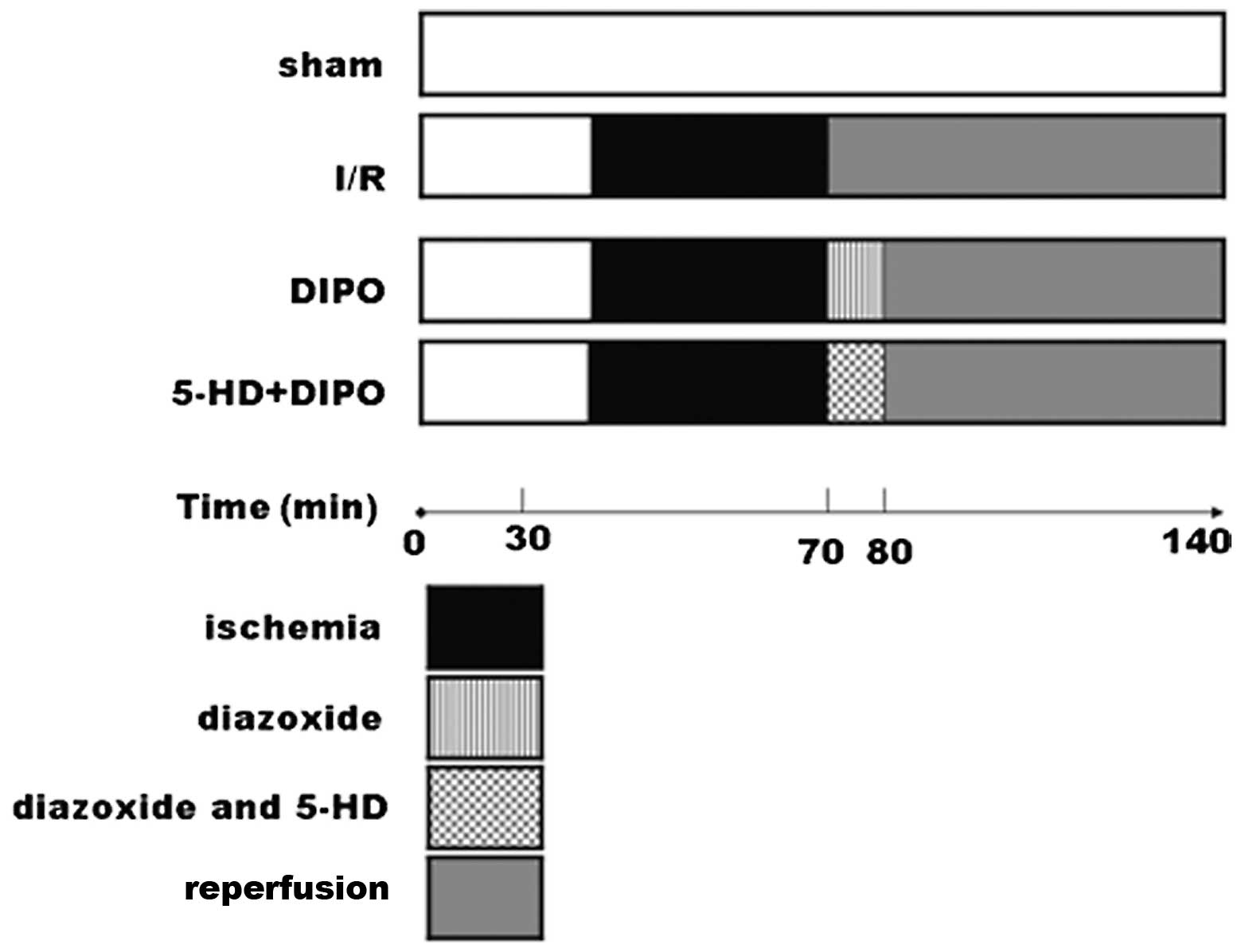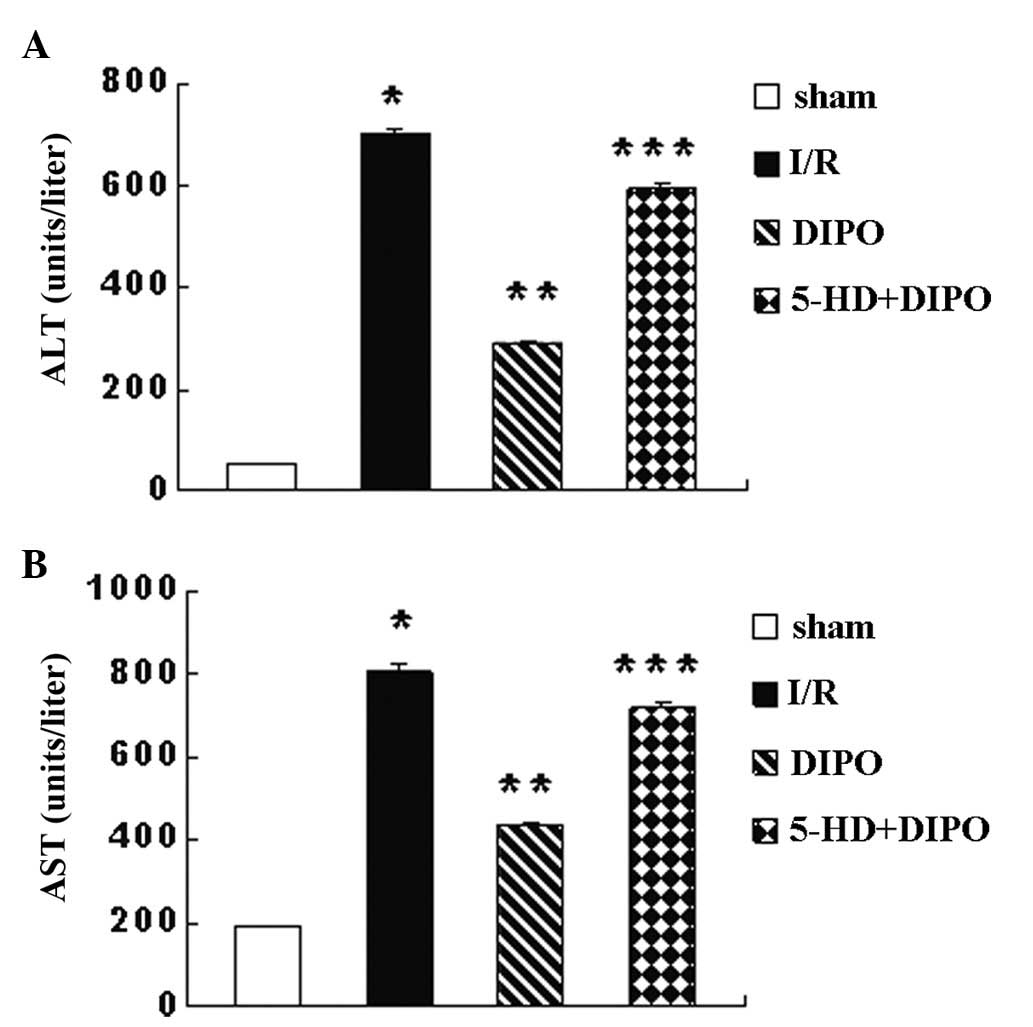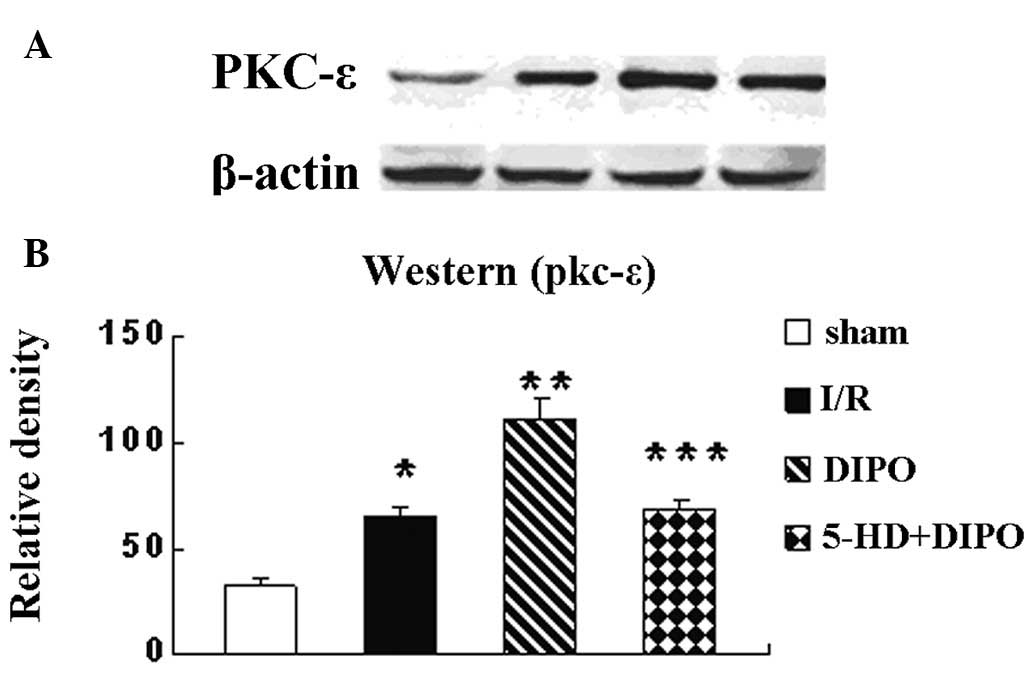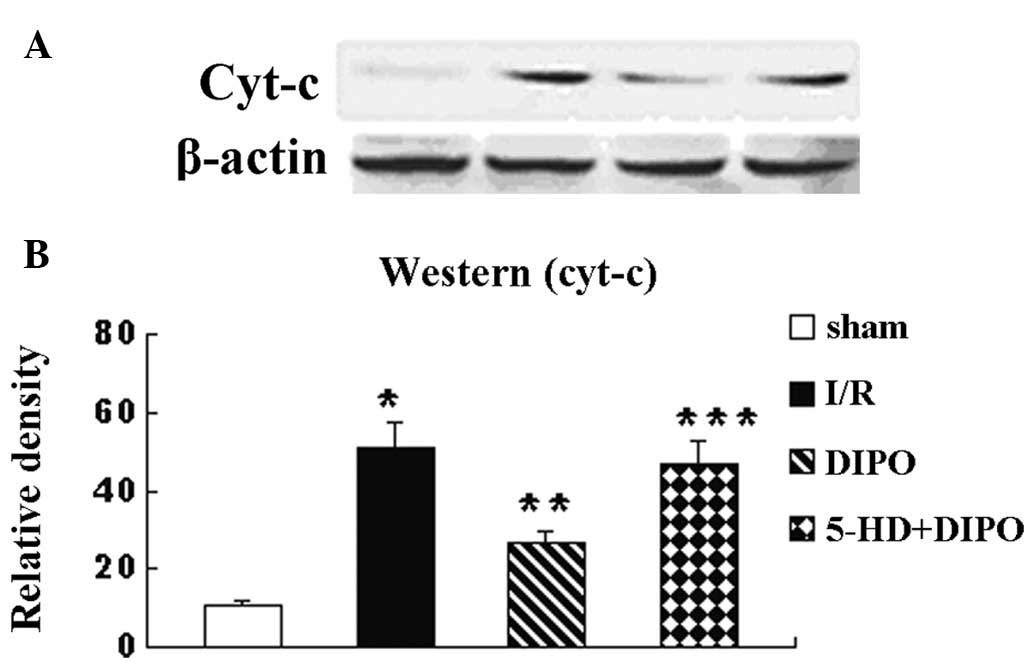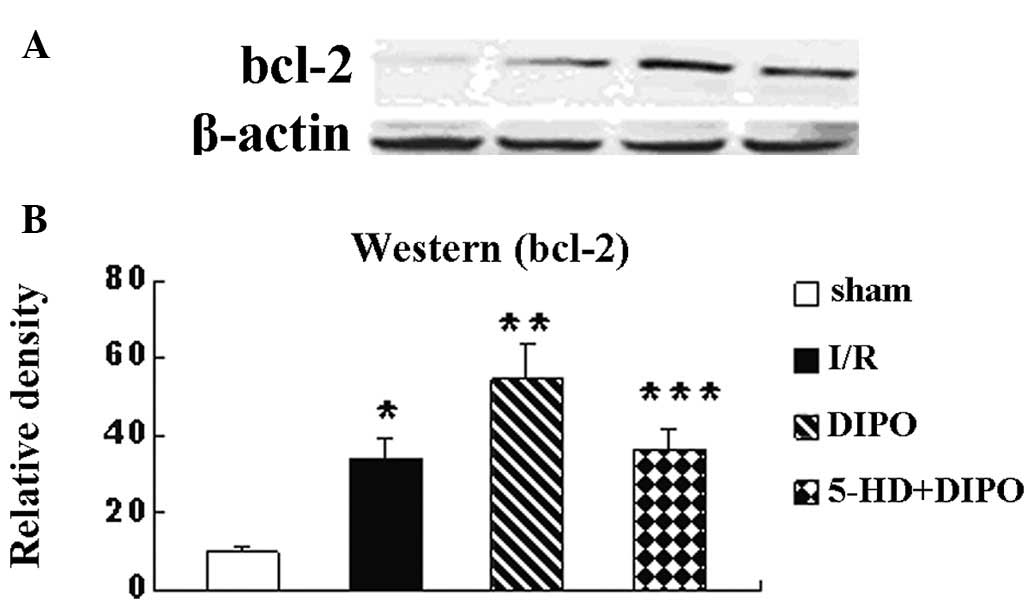|
1
|
Murry CE, Jennings RB and Reimer KA:
Preconditioning with ischemia: a delay of lethal cell injury in
ischemic myocardium. Circulation. 74:1124–1136. 1986. View Article : Google Scholar
|
|
2
|
Hausenloy DJ, Mocanu MM and Yellon DM:
Cross-talk between the survival kinases during early reperfusion:
its contribution to ischemic preconditioning. Cardiovasc Res.
63:305–312. 2004. View Article : Google Scholar : PubMed/NCBI
|
|
3
|
Liu GS, Thornton J, Van Winkle DM, et al:
Protection against infarction afforded by preconditioning is
mediated by A1 adenosine receptors in rabbit heart. Circulation.
84:350–356. 1991. View Article : Google Scholar : PubMed/NCBI
|
|
4
|
Leesar MA, Stoddard M, Ahmed M, et al:
Preconditioning of human myocardium with adenosine during coronary
angioplasty. Circulation. 95:2500–2507. 1997. View Article : Google Scholar : PubMed/NCBI
|
|
5
|
Costa AD, Garlid KD, West IC, et al:
Protein kinase G transmits the cardioprotective signal from cytosol
to mitochondria. Circ Res. 97:329–336. 2005. View Article : Google Scholar : PubMed/NCBI
|
|
6
|
Tsang A, Hausenloy DJ, Mocanu MM and
Yellon DM: Postconditioning: a form of ‘modified reperfusion’
protects the myocardium by activating the phosphatidylinositol
3-Kinase-Akt pathway. Circ Res. 95:230–232. 2004.
|
|
7
|
Darling CE, Jiang R, Maynard M, et al:
Postconditioning via stuttering reperfusion limits myocardial
infarct size in rabbit hearts: role of Erk1/2. Am J Physiol Heart
Circ Physiol. 289:H1618–H1626. 2005. View Article : Google Scholar : PubMed/NCBI
|
|
8
|
Zhao ZQ, Corvera JS, Halkos ME, et al:
Inhibition of myocardial injury by ischemic postconditioning during
reperfusion: comparison with ischemic preconditioning. Am J Physiol
Heart Circ Physiol. 285:H579–H588. 2003. View Article : Google Scholar : PubMed/NCBI
|
|
9
|
Heusch G: Postconditioning: old wine in a
new bottle? J Am Coll Cardiol. 44:1111–1112. 2004. View Article : Google Scholar : PubMed/NCBI
|
|
10
|
Vinten-Johansen J, Yellon DM and Opie LH:
Postconditioning: a simple clinically applicable procedure to
improve revascularization in acute myocardial infarction.
Circulation. 112:2085–2088. 2005. View Article : Google Scholar : PubMed/NCBI
|
|
11
|
Jabúrek M, Costa AD, Burton JR, et al:
Mitochondrial PKC epsilon and mitochondrial ATP-sensitive
K+ channel copurify and coreconstitute to form a
functioning signaling module in proteoliposomes. Circ Res.
99:878–883. 2006.PubMed/NCBI
|
|
12
|
Costa AD, Jakob R, Costa CL, et al: The
mechanism by which the mitochondrial ATP-sensitive K+
channel opening and H2O2 inhibit the
mitochondrial permeability transition. J Biol Chem.
281:20801–20808. 2006. View Article : Google Scholar : PubMed/NCBI
|
|
13
|
Dai AL, Fan LH, Zhang FJ, et al: Effects
of sevoflurane preconditioning and postconditioning on rat
myocardial stunning in ischemic reperfusion injury. J Zhejiang Univ
Sci B. 11:267–274. 2010. View Article : Google Scholar : PubMed/NCBI
|
|
14
|
Fu XC, Wang MW, Li SP and Wang HL:
Anti-apoptotic effect and the mechanism of orientin on
ischaemic/reperfused myocardium. J Asian Nat Prod Res. 8:265–272.
2006. View Article : Google Scholar : PubMed/NCBI
|
|
15
|
Ferrer I and Planas AM: Signaling of cell
death and cell survival following focal cerebral ischemia: life and
death struggle in the penumbra. J Neuropathol Exp Neurol.
62:329–339. 2003.PubMed/NCBI
|
|
16
|
Fryer RM, Eells JT, Hsu AK, et al:
Ischemic preconditioning in rats: role of mitochondrial
KATP channel in preservation of mitochondrial function.
Am J Physiol Heart Circ Physiol. 278:H305–H312. 2000.PubMed/NCBI
|
|
17
|
Liu Y, Sato T, Seharaseyson J, et al:
Mitochondrial ATP-dependent potassium channels. Viable candidate
effectors of ischemic preconditioning. Ann NY Acad Sci. 874:27–37.
1999. View Article : Google Scholar : PubMed/NCBI
|
|
18
|
Garlid KD, Paucek P, Yarov-Yarovoy V, et
al: The mitochondrial KATP channel as a receptor for
potassium channel openers. J Biol Chem. 271:8796–8799.
1996.PubMed/NCBI
|
|
19
|
Dos Santos P, Kowaltowski AJ, Laclau MN,
et al: Mechanisms by which opening the mitochondrial ATP-sensitive
K+ channel protects the ischemic heart. Am J Physiol
Heart Circ Physiol. 283:H284–H295. 2002.PubMed/NCBI
|
|
20
|
Kang PM, Haunstetter A, Aoki H, et al:
Morphological and molecular characterization of adult cardiomyocyte
apoptosis during hypoxia and reoxygenation. Circ Res. 87:118–125.
2000. View Article : Google Scholar : PubMed/NCBI
|
|
21
|
Zhang H, Li Q, Li Z, et al: The protection
of bcl-2 overexpression on rat cortical neuronal injury caused by
analogous ischemia/reperfusion in vitro. Neurosci Res. 62:140–146.
2008. View Article : Google Scholar : PubMed/NCBI
|
|
22
|
Yang J, Wang J, Zhu S, et al: C-reactive
protein augments hypoxia-induced apoptosis through
mitochondrion-dependent pathway in cardiac myocytes. Mol Cell
Biochem. 310:215–226. 2008. View Article : Google Scholar : PubMed/NCBI
|
|
23
|
Inagaki K, Hahn HS, Dorn GW II, et al:
Additive protection of the ischemic heart ex vivo by combined
treatment with delta-protein kinase c inhibitor and epsilon-protein
kinase C activator. Circulation. 108:869–875. 2003. View Article : Google Scholar : PubMed/NCBI
|
|
24
|
Inagaki K, Chen L, Ikeno F, et al:
Inhibition of delta-protein kinase C protects against reperfusion
injury of the ischemic heart in vivo. Circulation. 108:2304–2307.
2003. View Article : Google Scholar : PubMed/NCBI
|
|
25
|
Bright R, Raval AP, Dembner JM, et al:
Protein kinase C delta mediates cerebral reperfusion injury in
vivo. J Neurosci. 24:6880–6888. 2004. View Article : Google Scholar : PubMed/NCBI
|
|
26
|
Zatta AJ, Kin H, Lee G, et al:
Infarct-sparing effect of myocardial postconditioning is dependent
on protein kinase c signalling. Cardiovasc Res. 70:315–324. 2006.
View Article : Google Scholar : PubMed/NCBI
|
|
27
|
Churchill EN and Szweda LI: Translocation
of deltaPKC to mitochondria during cardiac reperfusion enhances
superoxide anion production and induces loss in mitochondrial
function. Arch Biochem Biophys. 439:194–199. 2005. View Article : Google Scholar
|
|
28
|
Murriel CL, Churchill E, Inagaki K, et al:
Protein kinase Cdelta activation induces apoptosis in response to
cardiac ischemia and reperfusion damage: a mechanism involving BAD
and the mitochondria. J Biol Chem. 279:47985–47991. 2004.
View Article : Google Scholar : PubMed/NCBI
|
|
29
|
Liu GS, Cohen MV, Mochly-Rosen D and
Downey JM: Protein kinase C-epsilon is responsible for the
protection of preconditioning in rabbit cardiomyocytes. J Mol Cell
Cardiol. 31:1937–1948. 1999. View Article : Google Scholar : PubMed/NCBI
|
|
30
|
Toma O, Weber NC, Wolter JI, et al:
Desflurane preconditioning induces time-dependent activation of
protein kinase C epsilon and extracellular signal-regulated kinase
1 and 2 in the rat heart in vivo. Anesthesiology. 101:1372–1380.
2004. View Article : Google Scholar : PubMed/NCBI
|
|
31
|
Ludwig LM, Weihrauch D, Kersten JR, et al:
Protein kinase C translocation and Src protein tyrosine kinase
activation mediate isoflurane-induced preconditioning in vivo:
potential downstream targets of mitochondrial adenosine
triphosphate-sensitive potassium channels and reactive oxygen
species. Anesthesiology. 100:532–539. 2004. View Article : Google Scholar
|
|
32
|
Ping P, Zhang J, Qiu Y, et al: Ischemic
preconditioning induces selective translocation of protein kinase C
isoforms epsilon and eta in the heart of conscious rabbits without
subcellular redistribution of total protein kinase C activity. Circ
Res. 81:404–414. 1997. View Article : Google Scholar
|
|
33
|
Novalija E, Kevin LG, Camara AKS, et al:
Reactive oxygen species precede the epsilon isoform of protein
kinase C in the anesthetic preconditioning signaling cascade.
Anesthesiology. 99:421–428. 2003. View Article : Google Scholar : PubMed/NCBI
|
|
34
|
Qiu Y, Ping P, Tang XL, et al: Direct
evidence that protein kinase C plays an essential role in the
development of late preconditioning against myocardial stunning in
conscious rabbits and that epsilon is the isoform involved. J Clin
Invest. 101:2182–2198. 1998. View
Article : Google Scholar
|
|
35
|
Yang Z, Sun W and Hu K: Molecular
mechanism underlying adenosine receptor-mediated mitochondrial
targeting of protein kinase C. Biochim Biophys Acta. 1823:950–958.
2012. View Article : Google Scholar : PubMed/NCBI
|
|
36
|
Kaljusto ML, Rutkovsky A, Stensløkken KO,
et al: Postconditioning in mouse hearts is inhibited by blocking
the reverse mode of the sodium-calcium exchanger. Interact
Cardiovasc Thorac Surg. 10:743–748. 2010. View Article : Google Scholar : PubMed/NCBI
|
|
37
|
Jones WK, Fan GC, Liao S, et al:
Peripheral nociception associated with surgical incision elicits
remote nonischemic cardioprotection via neurogenic activation of
protein kinase C signaling. Circulation. 120(Suppl 11): 1–9. 2009.
View Article : Google Scholar
|
|
38
|
Liu H, Zhang HY, Zhu X, et al:
Preconditioning blocks cardiocyte apoptosis: role of
K+ATP channels and PKCε. Am J Physiol Heart
Circ Physiol. 282:1380–1386. 2002. View Article : Google Scholar : PubMed/NCBI
|
|
39
|
McPherson BC and Yao Z: Morphine mimics
preconditioning via free radical signals and mitochondrial
KATP channels in myocytes. Circulation. 103:290–295.
2001. View Article : Google Scholar : PubMed/NCBI
|















